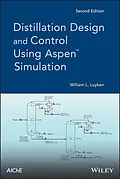Learn how to develop optimal steady-state designs for distillation systems As the search for new energy sources grows ever more urgent, distillation remains at the forefront among separation methods in the chemical, petroleum, and energy industries. Most importantly, as renewable sources of energy and chemical feedstocks continue to be developed, distillation design and control will become ever more important in our ability to ensure global sustainability. Using the commercial simulators Aspen Plus and Aspen Dynamics , this text enables readers to develop optimal steady-state designs for distillation systems. Moreover, readers will discover how to develop effective control structures. While traditional distillation texts focus on the steady-state economic aspects of distillation design, this text also addresses such issues as dynamic performance in the face of disturbances. Distillation Design and Control Using Aspen Simulation introduces the current status and future implications of this vital technology from the perspectives of steady-state design and dynamics. The book begins with a discussion of vapor-liquid phase equilibrium and then explains the core methods and approaches for analyzing distillation columns. Next, the author covers such topics as: Setting up a steady-state simulation Distillation economic optimization Steady-state calculations for control structure selection Control of petroleum fractionators Design and control of divided-wall columns Pressure-compensated temperature control in distillation columns Synthesizing four decades of research breakthroughs and practical applications in this dynamic field, Distillation Design and Control Using Aspen Simulation is a trusted reference that enables both students and experienced engineers to solve a broad range of challenging distillation problems.
Autorentext
WILLIAM L. LUYBEN, PhD, is Professor of Chemical Engineering at Lehigh University where he has taught for over forty-five years. Dr. Luyben spent nine years as an engineer with Exxon and DuPont. He has published fourteen books and more than 250 original research papers. Dr. Luyben is a 2003 recipient of the Computing Practice Award from the CAST Division of the AIChE. He was elected to the Process Control Hall of Fame in 2005. In 2011, the Separations Division of the AIChE recognized his contributions to distillation technology by a special honors session.
Inhalt
PREFACE TO THE SECOND EDITION xv
PREFACE TO THE FIRST EDITION xvii
1 FUNDAMENTALS OF VAPORLIQUIDEQUILIBRIUM (VLE) 1
1.1 Vapor Pressure 1
1.2 Binary VLE Phase Diagrams 3
1.3 Physical Property Methods 7
1.4 Relative Volatility 7
1.5 Bubble Point Calculations 8
1.6 Ternary Diagrams 9
1.7 VLE Nonideality 11
1.8 Residue Curves for Ternary Systems 15
1.9 Distillation Boundaries 22
1.10 Conclusions 25
Reference 27
2 ANALYSIS OF DISTILLATION COLUMNS 29
2.1 Design Degrees of Freedom 29
2.2 Binary McCabeThiele Method 30
2.2.1 Operating Lines 32
2.2.2 q-Line 33
2.2.3 Stepping Off Trays 35
2.2.4 Effect of Parameters 35
2.2.5 Limiting Conditions 36
2.3 Approximate Multicomponent Methods 36
2.3.1 Fenske Equation for Minimum Number of Trays 37
2.3.2 Underwood Equations for Minimum Reflux Ratio 37
2.4 Conclusions 38
3 SETTING UP A STEADY-STATE SIMULATION 39
3.1 Configuring a New Simulation 39
3.2 Specifying Chemical Components and Physical Properties 46
3.3 Specifying Stream Properties 51
3.4 Specifying Parameters of Equipment 52
3.4.1 Column C1 52
3.4.2 Valves and Pumps 55
3.5 Running the Simulation 57
3.6 Using Design Spec/Vary Function 58
3.7 Finding the Optimum Feed Tray and Minimum Conditions 70
3.7.1 Optimum Feed Tray 70
3.7.2 Minimum Reflux Ratio 71
3.7.3 Minimum Number of Trays 71
3.8 Column Sizing 72
3.8.1 Length 72
3.8.2 Diameter 72
3.9 Conceptual Design 74
3.10 Conclusions 80
4 DISTILLATION ECONOMIC OPTIMIZATION 81
4.1 Heuristic Optimization 81
4.1.1 Set Total Trays to Twice Minimum Number of Trays 81
4.1.2 Set Reflux Ratio to 1.2 Times Minimum Reflux Ratio 83
4.2 Economic Basis 83
4.3 Results 85
4.4 Operating Optimization 87
4.5 Optimum Pressure for Vacuum Columns 92
4.6 Conclusions 94
5 MORE COMPLEX DISTILLATION SYSTEMS 95
5.1 Extractive Distillation 95
5.1.1 Design 99
5.1.2 Simulation Issues 101
5.2 Ethanol Dehydration 105
5.2.1 VLLE Behavior 106
5.2.2 Process Flowsheet Simulation 109
5.2.3 Converging the Flowsheet 112
5.3 Pressure-Swing Azeotropic Distillation 115
5.4 Heat-Integrated Columns 121
5.4.1 Flowsheet 121
5.4.2 Converging for Neat Operation 122
5.5 Conclusions 126
6 STEADY-STATE CALCULATIONS FOR CONTROL STRUCTURE SELECTION 127
6.1 Control Structure Alternatives 127
6.1.1 Dual-Composition Control 127
6.1.2 Single-End Control 128
6.2 Feed Composition Sensitivity Analysis (ZSA) 128
6.3 Temperature Control Tray Selection 129
6.3.1 Summary of Methods 130
6.3.2 Binary Propane/Isobutane System 131
6.3.3 Ternary BTX System 135
6.3.4 Ternary Azeotropic System 139
6.4 Conclusions 144
Reference 144
7 CONVERTING FROM STEADY-STATE TO DYNAMIC SIMULATION 145
7.1 Equipment Sizing 146
7.2 Exporting to Aspen Dynamics 148
7.3 Opening the Dynamic Simulation in Aspen Dynamics 150
7.4 Installing Basic Controllers 152
7.4.1 Reflux 156
7.4.2 Issues 157
7.5 Installing Temperature and Composition Controllers 161
&...
